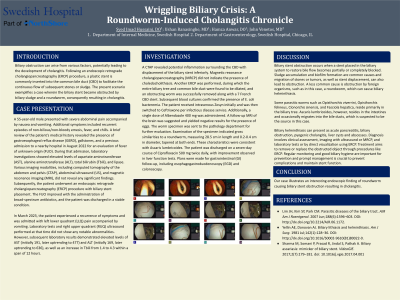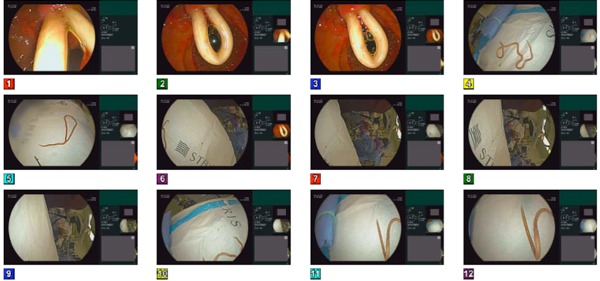Monday Poster Session
Category: Biliary/Pancreas
P1553 - Wriggling Biliary Crisis: A Roundworm-Induced Cholangitis Chronicle
Monday, October 23, 2023
10:30 AM - 4:15 PM PT
Location: Exhibit Hall

Has Audio

Syed I. Hussaini, DO
Swedish Hospital, part of Northshore University Health System
Chicago, IL
Presenting Author(s)
Award: Presidential Poster Award
Syed I. Hussaini, DO, Ushan A. Ranasinghe, MD, MS, Hamza Anwar, DO, John Venetos, MD
Swedish Hospital, part of Northshore University Health System, Chicago, IL
Introduction: Biliary obstruction can arise from various factors, potentially leading to the development of cholangitis. Following an endoscopic retrograde cholangiopancreatography (ERCP) procedure, a plastic stent is commonly inserted into the common bile duct (CBD) to facilitate the continuous flow of subsequent stones or sludge. The present scenario exemplifies a case wherein the biliary stent became obstructed by biliary sludge and a roundworm, consequently resulting in cholangitis.
Case Description/Methods: A 55-year-old male presented with severe abdominal pain, nausea, and vomiting. Past medical history revealed GERD, gallstones, and a prior hospital admission for fever of unknown origin (FUO). The patient underwent an ERCP procedure with biliary stent placement, which resolved the FUO. However, in March 2023, the patient experienced a recurrence of symptoms. Laboratory tests showed elevated AST, ALT, and Tbili levels. Imaging revealed potential inflammation around the common bile duct and displacement of the biliary stent. Another ERCP procedure was performed, removing an obstructing 28.5 cm worm and a 7 French CBD stent. Blood cultures confirmed E. coli bacteremia. The patient received antibiotics and a dose of Albendazole. Follow-up MRI of the brain was negative for eggs, and the worm specimen was consistent with Ascaris lumbricoides. The patient was discharged on a course of Ciprofloxacin, with plans for gastroenterology follow-up.
Discussion: Biliary stent obstruction occurs when a stent placed in the biliary system to restore bile flow becomes partially or completely blocked. Sludge accumulation and biofilm formation are common causes. Migration of stones or tumors, as well as stent displacement, can also lead to obstruction. A less common cause if obstruction by foreign organisms, such as in this case, a roundworm. Complications include cholangitis, an infection of the bile ducts. Diagnosis involves clinical assessment, imaging, and laboratory tests. Treatment aims to remove or replace the obstructed stent through procedures like ERCP. Regular monitoring and good biliary hygiene are important for prevention. Prompt management is crucial to prevent complications and maintain stent function.

Disclosures:
Syed I. Hussaini, DO, Ushan A. Ranasinghe, MD, MS, Hamza Anwar, DO, John Venetos, MD. P1553 - Wriggling Biliary Crisis: A Roundworm-Induced Cholangitis Chronicle, ACG 2023 Annual Scientific Meeting Abstracts. Vancouver, BC, Canada: American College of Gastroenterology.
Syed I. Hussaini, DO, Ushan A. Ranasinghe, MD, MS, Hamza Anwar, DO, John Venetos, MD
Swedish Hospital, part of Northshore University Health System, Chicago, IL
Introduction: Biliary obstruction can arise from various factors, potentially leading to the development of cholangitis. Following an endoscopic retrograde cholangiopancreatography (ERCP) procedure, a plastic stent is commonly inserted into the common bile duct (CBD) to facilitate the continuous flow of subsequent stones or sludge. The present scenario exemplifies a case wherein the biliary stent became obstructed by biliary sludge and a roundworm, consequently resulting in cholangitis.
Case Description/Methods: A 55-year-old male presented with severe abdominal pain, nausea, and vomiting. Past medical history revealed GERD, gallstones, and a prior hospital admission for fever of unknown origin (FUO). The patient underwent an ERCP procedure with biliary stent placement, which resolved the FUO. However, in March 2023, the patient experienced a recurrence of symptoms. Laboratory tests showed elevated AST, ALT, and Tbili levels. Imaging revealed potential inflammation around the common bile duct and displacement of the biliary stent. Another ERCP procedure was performed, removing an obstructing 28.5 cm worm and a 7 French CBD stent. Blood cultures confirmed E. coli bacteremia. The patient received antibiotics and a dose of Albendazole. Follow-up MRI of the brain was negative for eggs, and the worm specimen was consistent with Ascaris lumbricoides. The patient was discharged on a course of Ciprofloxacin, with plans for gastroenterology follow-up.
Discussion: Biliary stent obstruction occurs when a stent placed in the biliary system to restore bile flow becomes partially or completely blocked. Sludge accumulation and biofilm formation are common causes. Migration of stones or tumors, as well as stent displacement, can also lead to obstruction. A less common cause if obstruction by foreign organisms, such as in this case, a roundworm. Complications include cholangitis, an infection of the bile ducts. Diagnosis involves clinical assessment, imaging, and laboratory tests. Treatment aims to remove or replace the obstructed stent through procedures like ERCP. Regular monitoring and good biliary hygiene are important for prevention. Prompt management is crucial to prevent complications and maintain stent function.

Figure: Images taken from patient's ERCP revealing roundworm.
Disclosures:
Syed Hussaini indicated no relevant financial relationships.
Ushan Ranasinghe indicated no relevant financial relationships.
Hamza Anwar indicated no relevant financial relationships.
John Venetos indicated no relevant financial relationships.
Syed I. Hussaini, DO, Ushan A. Ranasinghe, MD, MS, Hamza Anwar, DO, John Venetos, MD. P1553 - Wriggling Biliary Crisis: A Roundworm-Induced Cholangitis Chronicle, ACG 2023 Annual Scientific Meeting Abstracts. Vancouver, BC, Canada: American College of Gastroenterology.

